THE BEST CLASS C RVs balance space, price, and comfort, making them a smart choice for many RVers. They’re large enough for families to enjoy a comfortable living space with home-like amenities. But they’re also nimble enough for your driver to navigate without feeling like they’re driving a bus.
These versatile Class C campers vary in size, price, and features. This guide highlights our top Class C RVs for sale, explores their standout features, and explains what sets this motorhome type apart.
Key Takeaways
- Class C RVs offer the ideal middle ground between compact camper vans and larger Class A motorhomes. They offer family-friendly layouts, full amenities, and easier drivability without requiring a special license in most states.
- Top Class C models include the Thor Freedom Elite 28HZF, Forest River Forester 3011DSF, and Jayco Greyhawk 30Z. Each showcases unique strengths in layout, storage, and travel comfort to suit a range of camping styles and group sizes.
- Pros include spacious interiors, onboard amenities, and good value, while cons range from limited fuel efficiency to parking challenges—making Class C RVs a strong option for families, couples, and solo travelers seeking comfort and versatility on the road.
Table of Contents
ToggleWhat Is a Class C RV?
Class C motorhomes are shorter than Class A RVs and feature a classic cabover bunk design, which makes them great for families with kids. They typically have a rear queen bed, sleeper sofas, dinettes, and full kitchens. Many Class C RVs offer storage in the trunk, interior pantry spaces, and overhead cabinets. Some Class C toy haulers have garage space for your gear.
When comparing the different RV types, Class C campers fall between Class B camper vans and Class A motorhomes in size. They are often praised for better gas mileage than Class A RVs while offering a more residential experience than Class B vans.
Here’s a quick summary of average Class C RV prices, sleeping capacities, lengths, and gross vehicle weights.
| Price (New) | Approximately $65,000 and up |
| Sleeping Capacity | Approximately 3 to 10 |
| Length | About 23’ to 41’ |
| Weight | Approximately 9,500 to 15,000 pounds |
Picks For the Best Class C Motorhomes
So, what are the best Class C motorhomes? This list combines function and value to bring you some of the best and most affordable Class C RV options.
Thor Freedom Elite 28HZF
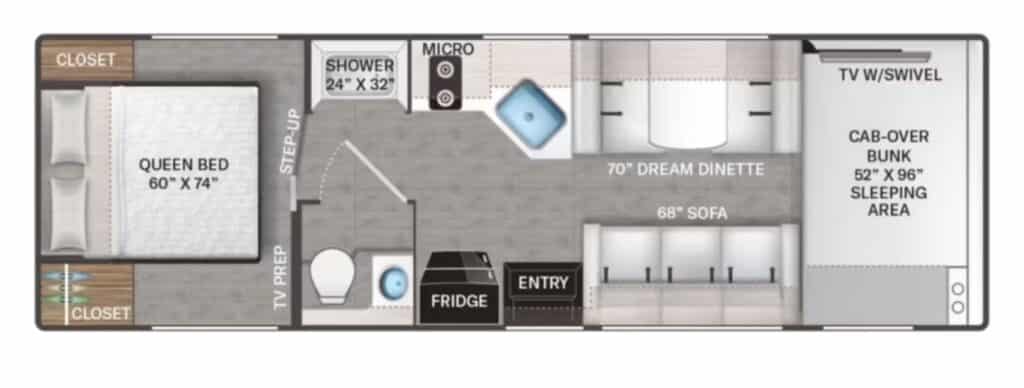
Specs
- Length: 30’
- Chassis: Ford® E-Series (or Chevrolet® truck)
- GVWR: 14,500 pounds
- Sleeps: Up to 6
The Freedom Elite 28HZF is a spacious and versatile option for families or couples ready to hit the road in comfort. With a private rear bedroom, cabover bunk, jackknife sofa, and convertible dinette, the 28HZF blends functionality and comfort, showcasing why Thor remains one of the top Class C RV manufacturers.
A seamless, one-piece fiberglass front cap helps prevent leaks and reduces road noise while driving, while an 8,000-pound trailer hitch gives you serious towing capability. Enjoy a 7” touchscreen dash radio in the cockpit with Bluetooth, Android Auto™, Apple CarPlay™, and SiriusXM™ Radio to stay connected and entertained. This family-friendly motorhome is ready to completely change how you vacation.
Pros:
- Cabover sleeping w/ telescoping bunk ladder
- 70” dream dinette
- MEGA-storage compartment w/ table
Cons:
- Minimal bathroom space
Forest River Forester Classic 3011DSF
Specs
- Length: 32’3”
- Chassis: Ford® E-450
- GVWR: 14,500 pounds
- Sleeps: Up to 8
The Forester 3011DSF is a spacious family Class C motorhome with features that make it an excellent fit for families or couples who like to bring guests along. The dual slide-outs expand your living space, including a rear bedroom slide-out with a walk-around queen bed facing dual wardrobes and a 12V TV.
The cabover bunk offers a dedicated sleeping space without sacrificing floorplan functionality, while the convertible dinette and sofa give you flexibility depending on who’s joining your trip. Blackout roller shades and LED lighting create a cozy, functional space to relax day or night. And if you want additional comfort, opt for a model with 12V-powered theater seats.
The campside kitchen runs nearly the full length of the living area, so you’re never short on counterspace. Plus, a flip-up extension near the entry gives you even more prep room. Meanwhile, a convection microwave and recessed range make it easy to cook real meals.
Explore Forester RVs
You’ll find plenty of smart storage throughout, including a pantry, overhead cabinets, and soft-close drawers. Outside, you’ll also find plenty of durable storage underneath, thanks to rotocast compartments designed to handle the rigors of the road.
Pros:
- Bedroom wardrobe storage
- EZRyde upgraded suspension system
- Side view cameras
- Large U-shaped dinette
Cons:
- Split bathroom
- Undersized kitchen backsplash
Jayco Greyhawk 30Z
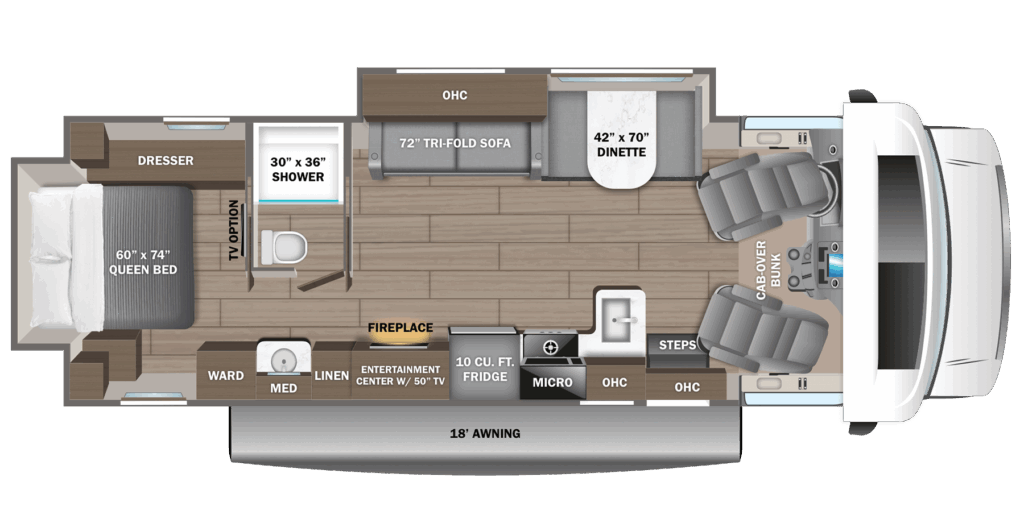
Specs
- Length: 32’6”
- Chassis: Ford® E-450
- GVWR: 14,500 pounds
- Sleeps: Up to 7
With an interior height of 84 inches and two slide-outs, the Greyhawk 30Z is ideal for families looking for comfort and space. This is one of the best Class C RVs featuring a full-wall slide on the driver’s side and a second in the bedroom, maximizing your interior living and sleeping space.
Inside, the Greyhawk blends residential finishes with practical design. Solid surface countertops, hardwood cabinet doors, and Jayco’s exclusive legless dinette create a streamlined living space. The kitchen includes a recessed range, convection microwave, and a flip-up counter extension, giving you extra prep space without crowding the entryway.
The Greyhawk 30Z also stands out for its driving experience. Equipped with Jayco’s JRIDE® Plus package, it delivers a noticeably smoother ride and improved handling. Climate control is powered by dual 13,500-BTU A/C units and a 30,000-BTU furnace, and an Onan® 4,000-watt generator provides reliable off-grid power.
Pros:
- Full-wall slide maximizes interior living space
- JRIDE® Plus improves ride quality and handling
- Dual A/C units standard
- Solid surface kitchen countertops with flip-up extension
Cons:
- Smaller pantry limits kitchen storage
- No window at the cooktop for added ventilation
Jayco Redhawk 24B
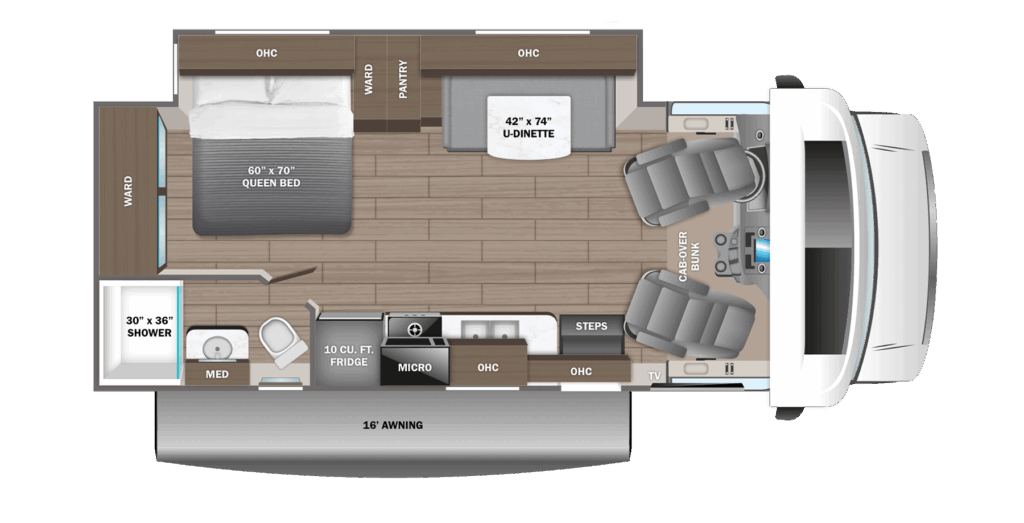
Specs
- Length: 26’8”
- Chassis: Ford® E-450
- GVWR: 14,500 pounds
- Sleeps: Up to 5
The Redhawk 24B is one of Jayco’s most popular Class C layouts, ideal for small families or couples. It offers a single-slide floor plan that packs comfort, functionality, and drivability into an RV under 27 feet. This coach delivers confident power whether you’re climbing grades or cruising the open highway.
The slide-out holds the U-shaped dinette and the east-to-west queen bed, opening up the central living area and allowing for better flow from front to back. The bed tucks into the rear corner, right by the double-door wardrobe.
Over the cab, a 750-pound-rated bunk offers a dedicated sleeping space for kids or extra guests. The dinette also converts, and it includes built-in seatbelt positions and child seat tethers for safe travel with little ones.
In the kitchen, you’ll find a recessed three-burner range with a glass cover, a convection microwave, a large 12V refrigerator, and soft-close drawers, so cooking feels more like home. A corner bath in the rear includes a shower with a skylight, motion-activated lighting, and an oxygen-infused shower head.
With the Redhawk 24B, driving and camp setup are easier with features like the backup and side view cameras, along with a 9-inch Sony® infotainment system that includes Apple CarPlay®, Android Auto™, and a tilt function.
Heated holding tanks help extend your camping season, while the 15,000-BTU A/C with heat pump, 30,000-BTU furnace, and Onan® 4,000-watt generator keep you comfortable and powered wherever you go.
Pros:
- Compact length for easier driving and parking
- JRIDE® driving and handling enhancements
- Catalytic converter theft deterrent
- Heated holding tanks for extended-season camping
Cons:
- Rear corner bed has limited walk-around access
- Smaller bathroom compared to dual-slide layouts
Thor Eddie Bauer 21EBF
Specs
- Length: 24’1”
- Chassis: Ford® E-Series
- GVWR: 12,500 pounds
- Sleeps: Up to 4
With its compact footprint, the Eddie Bauer 21EBF makes city driving, tight campsites, and weekend getaways feel effortless. If you like the idea of a Class B but want a more comfortable setup, the 21EBF may be right for you.
Sleeping accommodations include a corner queen bed, a 52” x 96” cabover bunk with a mounted TV, and a drop-down dinette conversion. It’s flexible enough for a couple, a small family, or occasional guests.
The galley kitchen is compact but capable. It has a two-burner gas cooktop under a glass cover, a convection microwave with an air fryer, a range hood with task lighting, and a 12-volt refrigerator with auto-generator start. A large stainless steel sink with a pull-down sprayer, pressed laminate countertops, and a flip-up counter extension make the space feel more functional than its size suggests.
Pushing out on the road, you’ll appreciate the dependable Ford® chassis, which can tow up to 8,000 pounds—perfect for a car, small trailer, or boat. Standard features like a power patio awning, rotocast storage bins, blackout shades, and a drop-down step with accent lighting make setup quick and easy.
Whether you’re exploring national parks or making weekend round trips, this Class C brings streamlined comfort and practicality in a nimble package.
Pros:
- Shorter length makes driving and parking easier
- Eddie Bauer brand styling throughout
- Drop-down stairwell entrance step
- Rear wall-mounted bike rack
Cons:
- No slide-out limits interior expansion
- Corner bed layout reduces walkaround access
- Compact bathroom may feel tight for some travelers
Thor Coleman 25EZF
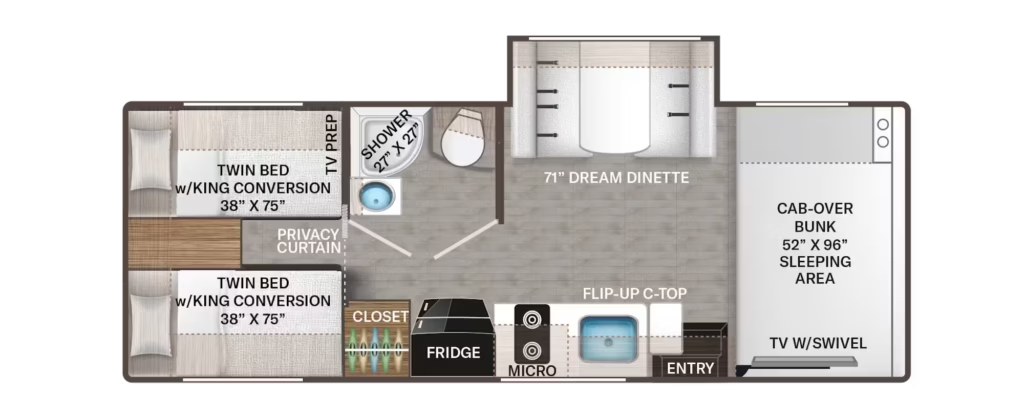
Specs
- Length: 26’5”
- Chassis: Ford® E-Series
- GVWR: 12,500 pounds
- Sleeps: Up to 4
This Coleman 25EZF offers a comfortable, family-friendly layout in a maneuverable package over 26 feet long. With a driver-side slide-out that houses the U-shaped dinette, the interior feels spacious while remaining easy to drive and park.
You’ll find a unique dual twin bed setup in the rear of the camper with a king bed conversion, which is excellent if you’re traveling with a friend or as a couple. In addition, the dinette in the living area converts to a bed, and a spacious cabover bunk includes a TV on a swivel. A full mid-ship bathroom features a shower with a motion-activated vent and a foot-flush toilet for added convenience.
The kitchen includes a recessed 2-burner cooktop with a glass cover, a range hood with task lighting, a convection microwave with an air-fryer feature, and a 12‑volt refrigerator with an auto generator start function. A large single‑bowl stainless steel sink with a pull-down sprayer, sink cover, pressed laminate countertops, and a flip‑up countertop extension gives you a practical workspace. A 12‑volt ceiling vent above the galley helps control heat and cooking odors.
Pros:
- Separate rear twin beds can be converted to a single king bed
- Space for mounting multiple TVs
- Single slide-out
- Dinette can become a proper bed
Cons:
- Two-burner stove
- No pantry
- Limited kitchen counterspace
Jayco Granite Ridge 22T
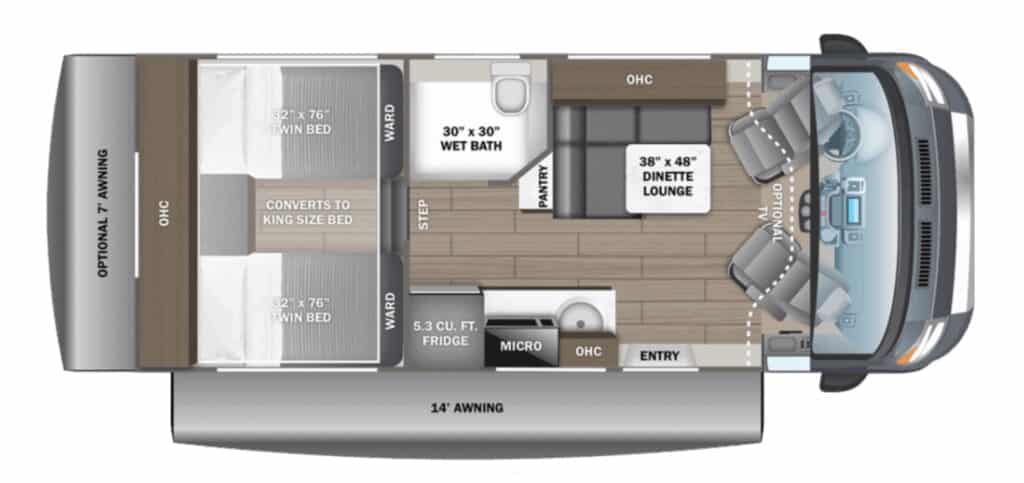
Specs
- Length: 23’5”
- Chassis: Ford Transit 350HD AWD
- GVWR: 11,030 pounds
- Sleeps: Up to 2
Designed for couples or solo adventurers, the Granite Ridge 22T packs premium features and rugged flexibility into a compact, go-anywhere Class C. Built on the AWD Ford Transit chassis and paired with Jayco’s JRide® handling package, the 22T is ready for elevation, rough roads, and long stretches of highway alike.
Inside, twin beds in the rear easily convert into a king-size sleeping area, giving you flexibility without sacrificing comfort. There’s also a full wet bath in the rear corner—complete with a cassette toilet and powered roof vent—so you’re not relying on campground facilities wherever you roam.
The galley is well-equipped with a two-burner cooktop, convection microwave, 12V compressor fridge, and a flip-up countertop extension. A forward lounge with lap belts and removable tables creates a functional daytime setup for eating, relaxing, or trip planning.
Storage is one of the 22T’s standout features. A heated gear garage in the rear holds oversized items like bikes, climbing gear, or inflatables, and includes L-track tie-downs and a power outlet to keep your setup organized. Add a 3.9kWh lithium battery, 360W of roof-mounted solar, and a 2,000W inverter, and you’re set.
Pros:
- AWD Ford Transit chassis for year-round, all-terrain drivability
- Heated gear garage with tie-downs and 110V outlet
- Off-grid-ready power setup (solar, lithium, inverter, auto-start generator)
- Convertible twin-to-king bed offers sleeping flexibility in a small space
Cons:
- No slide-out limits interior expansion
- Wet bath design may not appeal to all travelers
- Sleeping is limited to two
Winnebago Navion 24D

Specs
- Length: 25’6”
- Chassis: Mercedes-Benz® Sprinter
- GVWR: 11,030 pounds
- Sleeps: Up to 4
The Navion 24D is another “tweener” built on a Mercedes-Benz Sprinter chassis. But because it still includes the cabover bunk, we call it a Class C. It comes in at 25’6” and is easily maneuverable in smaller campgrounds. Inside, you’ll have several sleeping areas for the whole family, starting with the Murphy bed in the coach’s rear.
Now, the floorplan is a bit unconventional—more of an open-concept design. Because of the Murphy bed, the rear is a dedicated living space when not used for sleeping, which makes it feel a bit more roomy. This also allows for a more spacious rear bathroom.
Perhaps the best feature of the Navion 24D is the sizeable U-shaped dinette, which any family or group of friends will quickly make their home base.
Pros:
- A short RV that can still host guests
- Large overhead cabinets
- Pull-out leg rests on dinette
Cons:
- Lack of privacy in the primary bedroom area
- The smaller space with a Murphy bed may feel restrictive
Now that we’ve seen some of the best Class C RVs, consider whether a Class C RV might suit you.
Pros and Cons of Class C Motorhomes
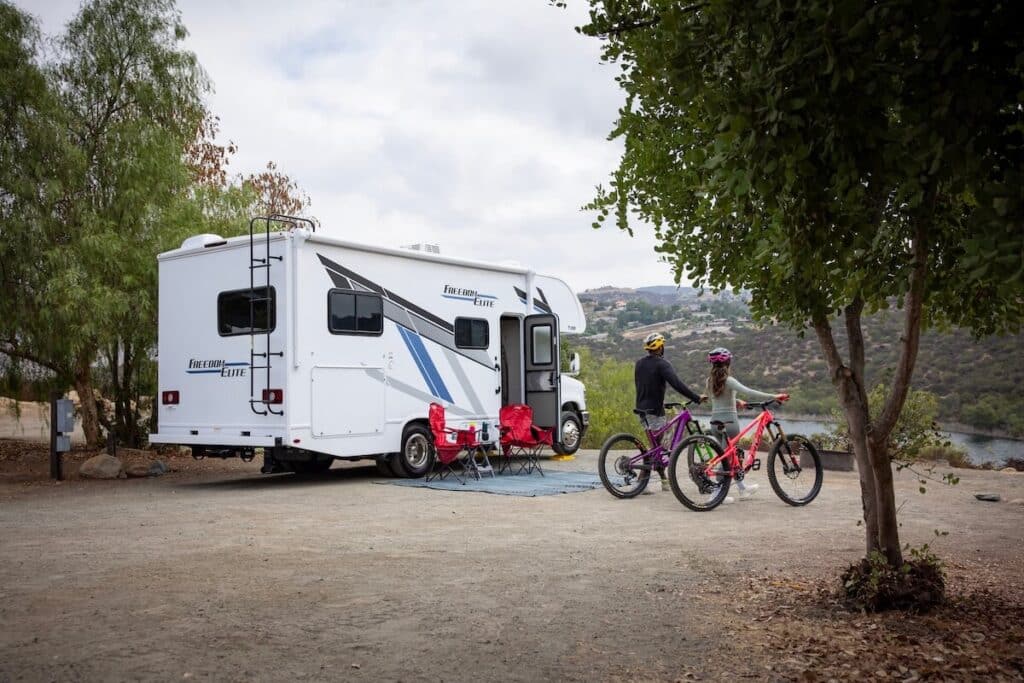
Like any motorhome, even the best Class C RVs have pros and cons. If you’re in the market for a new RV, consider the following:
Class C RV Benefits
- More space: Class C RVs offer more living space than Class B models, making them an excellent choice for families. These models often include separate sleeping quarters, dining areas, and even bathrooms with showers.
- Plenty of amenities: Class C motorhomes offer campers the comforts of home. Some models include full-size beds, kitchenettes with sinks and stovetops, microwaves, and small refrigerators.
- Easy drivability: Class C motorhomes are smaller and easier to drive than their Class A counterparts. They typically don’t require a special license, either.
- Suitable for long trips: Their size and amenities make Class C RVs an excellent choice for longer trips or extended stays at campsites.
Disadvantages of a Class C Camper
- Cost: Class C motorhomes can cost more than Class B campers, depending on their size, brand, and available features. RV financing is typically available and can help you find the right model for your budget.
- Parking challenges: Even though they’re smaller than Class A RVs, finding a parking spot for a Class C motorhome can still be challenging. Because it’s a camper, your HOA or city may have rules regarding where to park it when it’s not in use.
- Fuel efficiency: Class C RVs tend to be less fuel efficient than smaller Class B RVs or passenger vehicles because they are bigger.
Now that you know the pros and cons of Class C motorhomes, let’s answer other common questions about this RV type.
Do You Need A Special License To Drive a Class C?

Always check with your state’s Department of Motor Vehicles before you purchase, drive, or tow an RV to ensure you comply. However, most states don’t require a special license to drive a Class C motorhome because most models fall under the 26,000-pound weight limit that most states use to determine licensing requirements. While some weigh more than 26,000 pounds, their recreational status often allows you to get around the need for a special license.
Some states require special licenses or endorsements for specific vehicles, such as towed fifth wheel campers weighing over 10,000 pounds. Other states may have different terms for their vehicle or license classes.
Who Are Class C RVs Best for?

Class C RVs are great for everyone, from families to solo adventurers. Because they’re built on a van or truck chassis and share many amenities with Class A motorhomes, they balance maneuverability with function.
Families will love the sleeping space for the whole crew, especially in a Class C RV with bunk beds. Solo travelers will appreciate the size and maneuverability of smaller Class C motorhomes. Everyone benefits from bathrooms, a dining area, and small kitchenettes that make meal prep less hassle. The best Class C RVs can accommodate both couples and families.
What Does Class C Mean in RVs?
Typically built on a truck chassis, Class C RVs are smaller and less expensive than Class A RVs. Class C models tend to share one distinct feature: a sleeping area over the cab. When comparing Class C vs Class A motorhomes, you’ll also note that most C Class campers have smaller footprints.
Is a Class B or Class C RV Better?
Whether you’ll be happiest with a Class B vs a Class C RV depends on your needs. Class B RVs, or camper vans, are the smallest type of motorhome and are usually easier to park and maneuver. They are great for solo travelers or couples who prioritize mobility over space. Class C RVs are larger and offer more living space and amenities.
Which Is Easier to Drive: Class A or C?
Some argue that Class C RVs are easier to drive because they closely resemble trucks, which may offer a familiar driving experience. The driver’s seat is above the vehicle’s front wheels, giving you a better sense of the dimensions. This helps maneuver in a tight space.
Class A RVs are built on a bus-like chassis that’s larger and more difficult to handle. The driver sits up higher, which might make it hard to judge distances in narrow roads or parking lots. Ultimately, both RVs require patience and practice to drive safely. Go slow, stay alert, and follow all traffic laws.
Learn more about the easiest RVs to drive.
Can a Class C RV Tow a Car?
Many Class C RVs can tow cars behind them, but the specific capacity depends on the make and model. Some require additional equipment or modifications like tow bars, base plates, or braking systems to tow your car safely and legally. If you’re considering towing a car with your RV, always check the manufacturer’s recommendations for weight limits or other details.
Find the best vehicle to tow behind an RV.
Is It Worth Buying a Class C Motorhome?
Class C motorhomes are arguably the best type of motorized RV for first-time owners, especially families. They offer more living space than van campers and more amenities than pop up campers, but fewer than some higher-end travel trailers and fifth wheels. If you plan on spending a lot of time in your RV, the amenities in a Class C motorhome might be worth it. Class C motorhomes tend to hit a pricing “sweet spot” between Class A and B RVs.
Class C motorhomes are a fantastic way for campers to hit the open road. They combine the comforts of home, like bathrooms and kitchen prep space, with the ability to enjoy the great outdoors. They’re also more wallet-friendly than their larger Class A cousins.
Camping World has plenty to offer if you’re looking for a new or used Class C RV. We can help you find the most reliable Class C RV for your budget. Visit your nearest location to see available models up close or
Enjoy these additional resources to find your perfect motorhome:
- Super C RVs
- Which Class C RV Sleeps 8?
- Need a Class C Motorhome with a King Bed?
- What’s the Best Class C RV Under 25 Feet?
Which Class C motorhome from the list above would you choose, and why? Tell us in the comments below!
Author
-

For nearly 60 years, Camping World has made RV ownership and the outdoor lifestyle safe, fun, and easy.
View all posts









Great insights on Class C RVs! I’m in the market for one and found your detailed comparisons and recommendations really helpful. The tips on features to look for were especially useful. Thanks for sharing!
Glad you found this article useful!
Looking for a Good Used Class C Camper 350 To 450 Chassis with A Diesel Engine ❗️
Hi Vance,
Here’s a link to a collection of SUper C RVs you might be interested in: https://blog.campingworld.com/find-your-rv/best-super-c-rvs/
You can also search our entire Class C motorhome inventory here: https://rv.campingworld.com/rvclass/class-c-rvs
Hope that helps!